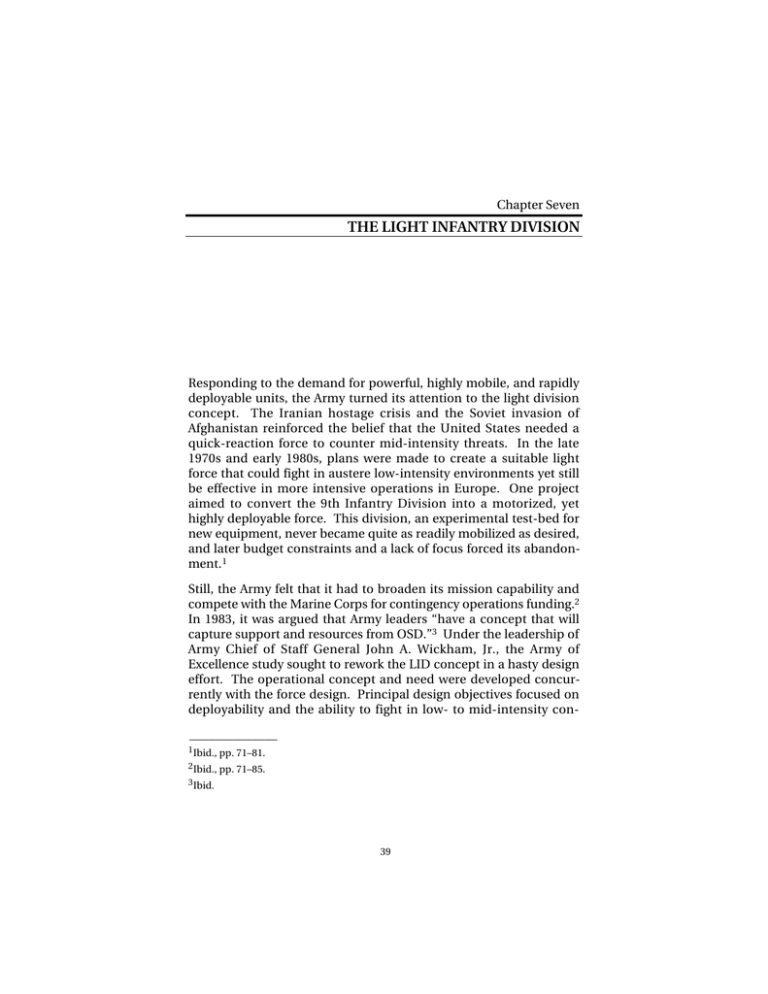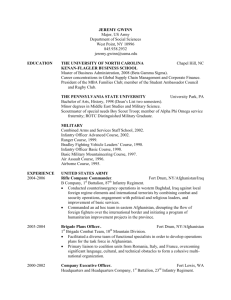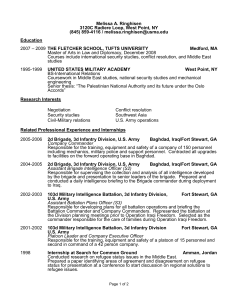THE LIGHT INFANTRY DIVISION
advertisement

Chapter Seven THE LIGHT INFANTRY DIVISION Responding to the demand for powerful, highly mobile, and rapidly deployable units, the Army turned its attention to the light division concept. The Iranian hostage crisis and the Soviet invasion of Afghanistan reinforced the belief that the United States needed a quick-reaction force to counter mid-intensity threats. In the late 1970s and early 1980s, plans were made to create a suitable light force that could fight in austere low-intensity environments yet still be effective in more intensive operations in Europe. One project aimed to convert the 9th Infantry Division into a motorized, yet highly deployable force. This division, an experimental test-bed for new equipment, never became quite as readily mobilized as desired, and later budget constraints and a lack of focus forced its abandonment. 1 Still, the Army felt that it had to broaden its mission capability and compete with the Marine Corps for contingency operations funding.2 In 1983, it was argued that Army leaders “have a concept that will capture support and resources from OSD.”3 Under the leadership of Army Chief of Staff General John A. Wickham, Jr., the Army of Excellence study sought to rework the LID concept in a hasty design effort. The operational concept and need were developed concurrently with the force design. Principal design objectives focused on deployability and the ability to fight in low- to mid-intensity con______________ 1 Ibid., pp. 71–81. 2 Ibid., pp. 71–85. 3 Ibid. 39 40 The U.S, Army Division in the Twentieth Century flicts, with the essential codicil that the LID have an antitank capability that would be useful in Europe. Wickham mandated that the LID design limit the division’s total strength to about 10,000 soldiers—half of them dedicated infantrymen—in nine maneuver battalions, with the whole division deployable in 400–500 C-141 sorties.4 As with past division reorganizations, manpower and other resource constraints were prime force design determinants. In late 1983, the light division was approved at a strength of 10,220 men (which later grew to more than 11,000 men, requiring about 550 C-141 sorties). This division was explicitly designed for combat against light enemy forces with only enough support “to permit the division to operate in a low intensity setting for 48 hours without external support.”5 Warfare that was anything more than strictly light in intensity would require substantial corps support, as would be the case for deployment to Europe, a secondary but essential mission. The force reflected this very limited role and the demands of deployability. It had three brigade headquarters, nine infantry battalions, division artillery with three 105-mm howitzer battalions, a combat aviation brigade with a reconnaissance squadron, attack helicopter and two combat aviation companies, a division support command, an MP company, an engineer battalion, an air defense battalion, and a signal battalion. Eliminated from the typical division structure were the adjutant general company, all organic vehicles and mortars in the line companies, general support artillery, and much organic capability in such areas as antiarmor, air defense, and nuclear, biological, and chemical (NBC) warfare. Mess and maintenance were consolidated at brigade level. MP and engineer missions were significantly reduced. 6 To compensate for a lack of heavy firepower and substantial support, the LID would depend on increased “soldier power”; individual and team training would be intensified to create a light infantry fighter ______________ 4 Ibid., pp. 84, 85, and 89; Timothy B. Hassell, Army of Excellence Final Report, Volume II: The Light Infantry Division (Fort Leavenworth , KS: Design Directorate, Combined Arms Combat Development Activity, 1984), pp. 1-5, 1-6. 5 Ibid., p. 86. 6 Ibid., pp. 86, 87. The Light Infantry Division 41 who used superior soldier skills, ingenuity, and toughness to overcome well-armed foes.7 Thus, the LID would depend on the soldier for success, not the traditional U.S. Army hallmarks: mobility and firepower. Eventually, one reserve and four active Army divisions assumed the LID concept design in 1985 and 1986. ______________ 7 John A. Wickham, Jr., United States Army Chief of Staff, White Paper, 1984: Light Infantry Divisions, April 16, 1984.


